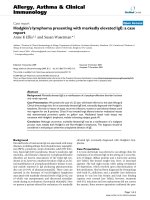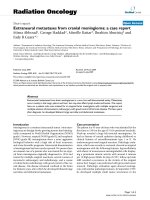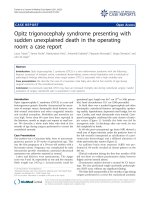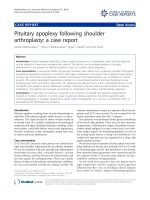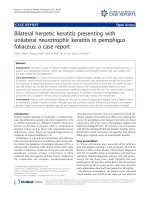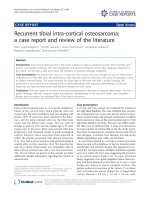Báo cáo y học: " Axillary silicone lymphadenopathy presenting with a lump and altered sensation in the breast: a case report" pot
Bạn đang xem bản rút gọn của tài liệu. Xem và tải ngay bản đầy đủ của tài liệu tại đây (2.27 MB, 5 trang )
Case report
Open Access
Axillary silicone lymphadenopathy presenting with a lump and
altered sensation in the breast: a case report
Simon T Adams*, Julie Cox and G Sam Rao
Address: University Hospital of North Durham, North Road, Durham, County Durham DH1 5TW, UK
Email: STA* - ; JC - ; GSR -
* Corresponding author
Published: 10 March 2009 Received: 31 January 2008
Accepted: 22 January 2009
Journal of Medical Case Reports 2009, 3:6442 doi: 10.1186/1752-1947-3-6442
This article is available from: />© 2009 Adams et al; licensee Cases Network Ltd.
This is an Open Access article distributed under the terms of the Creative Commons Attribution License (
/>which permits unrestricted use, distribution, and reproduction in any medium, provided the original work is properly cited.
Abstract
Introduction: Silicone lymphadenopathy is a rare but recognised complication of procedures
involving the use of silicone. It has a poorly understood mechanism but is thought to occur following
the transportation of silicone particles from silicone-containing prostheses to lymph nodes by
macrophages.
Case presentation: We report of a case involving a 35-year-old woman who presented to the
breast clinic with a breast lump and altered sensation below her left nipple 5 years after bilateral
cosmetic breast augmentations. A small lump was detected inferior to the nipple but clinical
examination and initial ultrasound investigation showed both implants to be intact. However,
mammography and magnetic resonance imaging of both breasts revealed both intracapsular and
extracapsular rupture of the left breast prosthesis. The patient went on to develop a flu-like illness
and tender lumps in the left axilla and right mastoid regions. An excision biopsy of the left axillary
lesion and replacement of the ruptured implant was performed. Subsequent histological analysis
showed that the axillary lump was a lymph node containing large amounts of silicone.
Conclusion: The exclusion of malignancy remains the priority when dealing with lumps in the breast
or axilla. Silicone lymphadenopathy should however be considered as a differential diagnosis in
patients in whom silicone prostheses are present.
Introduction
Silicone has been used in surgery for over 30 years in
procedures such as joint replacement and breast augmen-
tation. Initially, it enjoyed a reputation as being a
biologically inert substance. Over the past 15 to 20
years, however, concerns over the safety of silicone
implants have culminated in several well-publicised legal
cases and negative media reports. Its use has been curtailed
for fears of association with granulomatous reactions and,
in rarer cases, malignancy [1, 2]. Injections of free silicone
into breast tissue have long been abandoned in the United
States following the development in some women of
disfiguring complications such as gravitational migration
through the soft tissues to distant sites [1, 3].
Page 1 of 5
(page number not for citation purposes)
Silicone is a non-biodegradable prosthetic material which
elicits relatively little local inflammation in most people
due to its low tissue immunogenicity [3–6]. It is composed
of dimethylsiloxane polymers which can result in differing
properties and products according to the variation in their
chain lengths and cross-links [4, 7]. Liquid silicone consists
of short chains, and gels are made from long chains [4].
Despite its initial reputation as a biologically inert
substance, it has been associated in the literature with
numerous, albeit rare, complications including local and
systemic granulomatous inflammatory reactions affecting
breast tissue, lymph nodes, joint capsules, the heart, liver
and kidneys. In addition, it has been suggested that
silicone may be a causative factor in the development of
adult respiratory distress syndro me (ARDS), vari ous
connective tissue and autoimmune diseases and human
adjuvant disease [4, 8, 9]. At present, the mechanism of
such complications is uncertain and in some cases, proof
of such a relationship remains a source of controversy [2,
9– 11]. Malignant lesions including lymphoma and
cancers of the breast and lung have arisen in those with
silicone prostheses although again there has yet to be any
firm proof of its carcinogenicity. Indeed, some papers have
shown a reduced relative risk of breast cancer in women
with breast implants [1, 4, 12]. The inflammatory reaction
is thought to be more pronounced in the lymph nodes
than in connective tissue [1, 8].
Silicone particles can migrate through tissues following
either rupture or erosion of a silicone-containing surface or
through con tinued leakage through an intact surface
[1,3,4,6,8]. The risk of rupture and/or leakage increases
with increasing age of the implant, the site of implantation
(retroglandular as opposed to submuscular), the presence
of local tissue contractures and/or symptoms and the type
and/or manufacturer of the implant used [6,7,13]. The
average age at rupture varies between studies but is in the
region of 10 to 13 years and it is best diagnosed with
magnetic resonance imaging (MRI) scanning [4,14].
Rupture itself is normally a relatively harmless
condition which only rarely progresses and becomes
symptomatic [15].
When leakage does occur, silicone can cause fibrosis and
foreign body granulomatous reactions, especially when
combined with certain fatty acids, resulting in pain and
contractures [4, 6]. Once silicone particles have breached
the confines of their prosthesis and passed through any
local fibrotic reaction, they may be transported to regional
lymph nodes by macrophages in the reticulo-endothelial
system [1]. The resulting granulomatous reactions may
present as lymphadenopathy and, when sited in the axilla,
malignancy of the ipsilateral breast is a diagnosis which
needs to be excluded. Indeed, it is not impossible for both
silicone granulomata and breast cancer metastases to
coexist in the same lymph node [6].
Silicone lymphadenopathy has been reported more
frequently following joint surgery than following breast
augmentation either by silicone gel implants or silicone
injection [1, 6]. When associated with breast augmenta-
tion, it primarily affects the axillary nodes but cases have
been reported involving intramammary, internal mam-
mary and supraclavicular nodes [3, 5].
Fine needle aspiration (FNA) of affected lymph nodes has
been shown to be a cost effective and accurate method of
excluding malignancy and diagnosing implant disruption
in patients with silicone prostheses presenting with an
axillary mass [6]. Under such circumstances, fine needle
aspiration cytology (FNAC) shows a foreign body reactive
lymphoid background with numerous giant cells [1, 6].
Specifically, one sees cystic spaces with multivacuolated
macrophages but relatively few multinucleated giant cells
[1, 8]. Other granulomatous processes can be excluded if
birefringent particles are found in the macrophages
whereas in silicone reactive macrophages, the vacuoles
contain refractile, homogenous and faintly yellow non-
birefringent material [1, 3, 6].
Some papers have suggested that a conservative approach
involving excision of the axillary nodes is favourable. The
rationale for this is that silicone granulomata have been
found as incidental findings in axillary nodes removed at
mastectomy for breast cancer in the presence of intact
breast prostheses [1]. Also it has been suggested that
silicone may dilute the cellular elements within the node
and thus mask t he presen ce of cancer ce lls [1] . If
intramammary nodes are affected, then excision has
been recommended as mamm ography is unable to
differentiate between benign and malignant pathology [5].
Case presentation
A 35-year-old British Caucasian woman was referred by
her general practitioner to our breast symptomatic services
following a 3-week history of a lump below her left nipple.
She also complained of some itchiness and a hot feeling in
the same region. She had undergone bilateral breast
augmentation using subglandular cohesive gel silicone
implants 5 years previously.
Clinical examination revealed soft healthy implants which
were clinically intact. There was a 2 mm mobile lump
behind the left nipple.
Initial ultrasound investigation showed both implants to
be intact but there were multiple hypoechoic areas at the
symptomatic site in the left retroareolar region which
appeared superficial to the implant. Mammography
Page 2 of 5
(page number not for citation purposes)
Journal of Medical Case Reports 2009, 3:6442 />showed an irregular contour of the left implant. A
magnetic resonance imaging (MRI) scan of both breasts
was suggestive of both intracapsular and extracapsular
rupture of the left breast prosthesis.
The patient was seen in the breast clinic with the results of
the radiological investigations (Figures 1, 2 and 3). On this
occasion, she complained of a tender lump in the left
axilla after a flu-like illness. Clinically, the lump was
thought to be a lymph node and following review a
month later, she was listed for excision biopsy of the
axillary lesion.
Before the excision biopsy, the patient was reviewed as an
outpatient by the plastic surgeon who had performed the
original augmentation procedure. At this time, a similar
tender lump to the left axillary mass was found in the right
mastoid region.
A combined procedure involving excision biopsy of the left
axillary lesion and replacement of the ruptured implant was
performed. Pus-like fluid was seen to surround the ruptured
implant and ooze from the axillary node. Subsequent
histological analysis showed that the axillary lymph node
contained large amounts of silicone and demonstrated a
lipogranulomatous reaction (Figures 4, 5).
Two weeks postoperatively, the patient had clinically
improved with resolution of her operative discomfort.
Discussion and Conclusion
This case demonstrates the need to retain an open mind
when dealing with lumps in the breast and axilla and also
reinforces the need to employ a high index of suspicion.
Silicone lymphadenopathy is a rare complication of
procedures involving insertion of silicone-containing
prostheses and, whilst the diagnosis must be considered,
the need to exclude malignancy histologically is
paramount.
Figure 1.
Ultrasound of the left breast implant. Demonstrates several
hypoechoic areas measuring 9 and 7mm, respectively,
suggestive of extracapsular rupture (a) with gross disorgani-
sation of the internal implant structure in keeping with
intracapsular rupture (b).
Figure 2.
Bilateral mammography (a)–(d). Demonstrates irregularity of
the contour of the left breast implant (blue arrow).
Page 3 of 5
(page number not for citation purposes)
Journal of Medical Case Reports 2009, 3:6442 />Abbreviations
ARDS, adult respiratory distress syndrome; FNA, fine
needle aspiration; FNAC, fine needle aspiration cytology;
MRI, magnetic resonance imaging
Figure 3.
Magnetic resonance imaging of the breasts. Axial T1 weighted
fat suppressed images through the left implant (a)–(c)
demonstrate extracapsular silicone (yellow arrow) with gross
disorganisation and collapse of the implant with a positive
“linguine sign” (green arrow). Features are of a collapsed intra
and extracapsular rupture.
Figure 4.
Lymph node (¥40). Demonstrates the subcapsular sinus
diffusely expanded by vacuolated histiocytes.
Figure 5.
Multinucleate giant cells (¥200). Demonstrate vacuoles some
of which contain refractile material consistent with silicone.
Page 4 of 5
(page number not for citation purposes)
Journal of Medical Case Reports 2009, 3:6442 />Consent
Written informed consent was obtained from the patient
for publication of this case report and any accompanying
images. A copy of the written consent is available for
review by the Editor-in-Chief of this journal.
Competing interests
The authors declare that they have no competing interests.
Authors’ contributions
STA was the primary author of the manuscript; JC
provided critical appraisal and re-writing of initial drafts
of the manuscript, and provided the radiological imaging
and legends. SR was the senior author, and provided
critical appraisal and re-writing of drafts of the manuscript.
Acknowledgments
The authors would like to thank Mr KWR Callanan who
obtained consent from the patient for publication of this
case report and Dr Paul Barrett who provided the
histological imaging and legends.
References
1. Tabatowski K, Elson CE, Johnston WW: Silicone lymphadeno-
pathy in a patient with mammary prosthesis. Fine needle
aspiration cytology, histology and analytical electron micro-
scopy. Acta Cytol 1990, 34(1):10-14.
2. Tugwell P, Wells G, Peterson J, Welch V, Page J, Davison C,
McGowan J, Ramroth D, Shea B: Do silicone breast implants
cause rheumatological disorders? A systematic review for a
court-appointed national science panel. Arthritis Rheum 2001,
44(11):2477-2484.
3. Kao CC, Rand RP, Holt CA, Pierce RH, Timmons JH, Wood DE:
Intern al mammary silicone lymphadenopathy mimicking
recurrent breast cancer. Plast Reconstr Surg 1997, 99(1):225-229.
4. Cook PD, Osborne BM , Co nnor RL, Strauss JF: Follicular
lymphoma adjacent to foreign body granulomatous inflam-
mation and fibrosis surrounding silicone breast prosthesis. Am
J Surg Pathol 1995, 19(6):712-717.
5. Rivero MA, Schwartz DS, Mies C: Silicone lymphadenopathy
involving intramammary lymph nodes: a new complication of
silicone mammaplasty. AJR Am J Roentgenol 1994,
162(5):1089-1090.
6. Santos-Briz Jr A, Lopez-Rios F, Santos-Briz A, De Agustin PP:
Granulomatous reaction to silicone in axillary lymph nodes –
a case report with cytologic findings. Acta Cytol 1999,
43(6):1163-1165.
7. Shaaban H, Jmor S, Alvi R: Leakage and silicone lymphadeno-
pathy with cohesive breast implant. Br J Plast Surg 2003,
56(5):518-519.
8. Lin RP, DiLeonardo M, Jacoby RA: Silicone lymphadenopathy – a
case report and review of the literature. Am J Dermatopath 1993,
15(1):82-84.
9. Sanchez-Guerrero J, Colditz GA, Karlson EW, Hunter DJ, Speizer FE,
Liang MH: Silicone breast implants and the risk of connective-
tissue diseases and symptoms. NEnglJMed1995,
332(25):1666-1670.
10. Janowsky EC, Kupper LL, Hulka BS: Meta-analyses of the relation
between silicone breast implants and the risk of connective-
tissue disease. N Engl J Med 2000, 342(11):781-790.
11. Kjoller K, Mellemkjaer L, McLaughlin JK, Winther JF, Lipworth L, Blot
WJ, Fryzek J, Olsen JH: Connective tissue disease and other
rheumatic conditions following cosmetic breast implantation
in Denmark. Arch Intern Med 2001, 161(7):973-979.
12. Kern KA, Flannery JT, Kuehn PG: Carcinogenic potential of
silicone breast implants: A Connecticut statewide study. Plast
Reconstr Surg 1997, 100(3):737-747.
13. Feng LJ, Amini SB: Analysis of risk factors associated with
rupture of silicone gel breast implants. Plast Reconstr Surg 1999,
104
(4):955-963.
14. Holmich LR, Friis S, Fryzek JP, Vejborg IM, Conrad C, Sletting S,
Kjoller K, McLaughlin JK, Olsen JH: Incidence of silicone breast
implant rupture. Arch Surg 2003, 138(7):801-806.
15. Holmich LR, Vejborg IM, Conrad C, Sletting S, Hoier MM, Fryzek JP,
McLaughlin JK, Kjoller K, Wiik A, Friis S: Untreated silicone breast
implant rupture. Plast Reconstr Surg 2004, 114(1):204-214.
Page 5 of 5
(page number not for citation purposes)
Journal of Medical Case Reports 2009, 3:6442 />Do you have a case to share?
Submit your case report today
• Rapid peer review
• Fast publication
• PubMed indexing
• Inclusion in Cases Database
Any patient, any case, can teach us
something
www.casesnetwork.com

